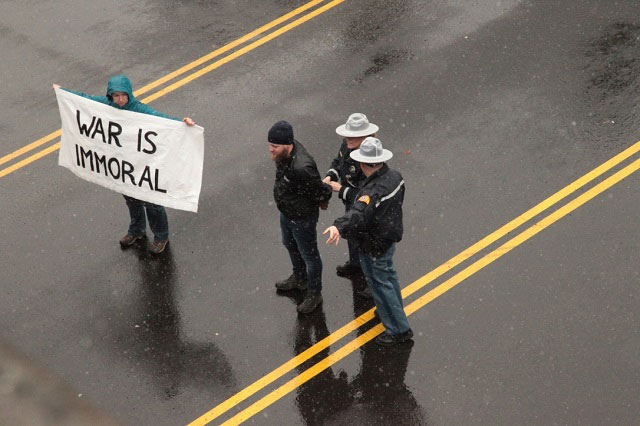
It was March 7, and I wasn’t expecting the snow. I tucked my fingers into my sleeves, wishing I hadn’t left my gloves in California. I had traveled to the Naval Base Kitsap-Bangor to demonstrate at the site of the largest stockpile of deployed nuclear weapons in the United States, likely the world. With a dozen protesters, I occupied lanes of traffic. Down this road, past the gate on Trigger Avenue, on the Hood Canal just 20 miles from Seattle, sits a deadly fleet of nuclear submarines. Each vessel has the capacity for 24 Trident II D5 missiles, eight warheads apiece, with a 4,000-mile target radius. The US has 14 Trident submarines, eight to 10 of which are at sea at any given time.
Nuclear annihilation is an immediate threat in today’s tenuous global political climate. Nine nations are poised to destroy their enemy by nuclear attack and throw the world into climatic chaos that will last for years. Thirty countries have nuclear power, which produces the plutonium needed for nuclear weapons. Multinational corporations such as Boeing, Lockheed Martin and Honeywell have raked in billions to make this possible, ever producing improved technology for the world’s nuclear arsenal. These weapons, for decades, have been tested on Native peoples in French Polynesia, Marshall Islands and Australia. Unbridled war-making has married political and private interests, mutually ensuring power by force and endless profits, sparing the safety of no one.
Activists of every stripe know the sadness of seeing and experiencing the vastness of injustice. I grieve for the Earth that has been scarred, mined, poisoned and commodified in pursuit of the nationalist pretense of security. I am ashamed to be bound by the capitalist system that has produced this nuclear world, a system predicated on the terrorizing and disenfranchisement of many in order to satisfy the greed of the few. Within this dark reality, I’ve also realized my desire to act and more concretely understand the nuclear threat.
For that reason, I participate in nonviolent resistance, a standard tactic in any movement for social change, and a favorite of the anti-nuclear movement. As I learned during an archiving internship with the Nuclear Resister, hundreds of thousands of people demonstrated in the 1980s at military bases, arms manufacturers, nuclear power plants and missile silos. Yet with the end of the Cold War, and sequential fall of the Soviet Union and talks of deescalation, many activists were placated and mobilization fizzled. Despite efforts such as Think Outside the Bomb to bring in younger generations, today’s resistance is primarily carried by a small group of diligent, aging, white, faith-based activists.
The new frontier for mass mobilization for anti-nuclear activists looks to be on the global scale. As global capitalism and military colonialism push the world to the brink of nuclear midnight, an international alliance is a direct and resolute response. One example being a 20-week German campaign of nonviolent direct action to rid Büchel Air Base of the 20 US nuclear bombs housed there. This began on March 26, 2017, a day before the United Nations commenced talks on a worldwide nuclear ban. An international delegation will join the protests in mid-July.
Wherever it occurs, nonviolent action should teach, promote hope, foster a healthier movement, and illuminate the truth that injustices are causally linked. Many are throwing stones at the same giant and, in the United States alone, anti-nuclear activists have ample opportunity for collaboration. Indigenous communities have seen their land stolen and poisoned by mining developments and US nuclear testing. Communities of color, which are disproportionately and systematically impoverished, are continually neglected tras the US spends billions of dollars maintaining its nuclear arsenal. Radioactive waste sites threaten to poison communities’ water and land. Showing up for communities in distress, seeing all forms of liberation as key to a future worth saving, should be the calling card of nuclear resisters.
While I stood in front of the entrance to Naval Base Kitsap-Bangor, I was wet and cold, trying to keep my grief from curdling into helplessness. Cars slowed to a stop. Friends read the Nuremberg Principles to the men in digital-blue camouflage. I was soon escorted to the shoulder by a stern police officer, and shook off the sense of foolishness, scoffed at the notion of heroism. There is work aplenty. I was doing my share. If there is hope for a better world, we have no choice but to make it so.
Join us in defending the truth before it’s too late
The future of independent journalism is uncertain, and the consequences of losing it are too grave to ignore. To ensure Truthout remains safe, strong, and free, we need to raise $17,000 by midnight tonight. Every dollar raised goes directly toward the costs of producing news you can trust.
Please give what you can — because by supporting us with a tax-deductible donation, you’re not just preserving a source of news, you’re helping to safeguard what’s left of our democracy.